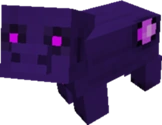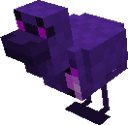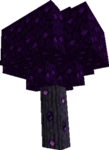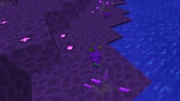
A Tainted ravine.
Description
If you think of Vis as the air, Taint can be likened to the smog that pollutes it. Technically speaking, it is *not* a somehow negatively charged form of Vis, but rather a completely separate type of magical energy. It can occur naturally or be created by thaumaturgic devices like the Crucible as a waste product during the process of converting matter into Vis.
The rating of naturally occurring Taint is usually much lower than that of Vis. Unlike regular Vis, Tainted Vis spreads a lot more quickly into neighboring areas, however. As some chunks spawn with an unusually high rate of Tainted Vis, this can cause a natural Taint Zone (see below) to spawn, as the Tainted Vis quickly spreads to the neighboring areas, corrupting everything in its Path.
Unfortunately, the major source of Taint is caused by many of the thaumaturgic devices used in Minecraftia. The mystical processes that create the wondrous objects and other magical miracles occasionally cause Taint as a byproduct. A wise thaumaturge will make sure to take great care when plying his craft to prevent mishaps.
Tainted Vis

Tainted trees, plants and ground.
Like Vis, can be found and stored in a pure, non-Aura form; so physical Taint can be found or created through magical processes. It occasionally forms into Tainted Crystals like pure Vis, but usually it is created as a byproduct of the crucible smelting process.
If you have already researched the Concentrated Evil upgrade, you can also put Tainted Crystals into Thaumic Condensers to have them draw the Taint directly out of the atmosphere. If stored in regular Vis Tanks, the Tainted Vis will slowly corrupt and damage the tank.
If you want to draw Taint out of the atmosphere for later usage or to clean up a Taint Zone, you should consider storing the Taint in the much more durable Reinforced Tanks, especially if you want to store it for a long amount of time.
Taint Gone Wild

A vast Tainted Zone.

A taint Pod, spewing taint into the air.
If the Taint rating in the local area ever rises high enough and the Aura rating is very low at the same time, strange things start happening.
Plants and creatures begin to change as a strange, purple growth appears and subsequently spreads everywhere. The ground will become a nasty, purple mud that squishes under your steps. Strange, glowing weeds and purple gas pods that spew poisonous gas clouds will start to grow everywhere.
The gas from those pods will negatively charge the aura, which further increases the Taint rating and speeds up the corruption of the surrounding terrain.
Normally docile creatures like pigs, cows and chickens suddenly become aggressive and will attack all uncorrupted life forms, including you.
This phenomenon can be referred to as a local Taint infection, while the infected terrain will be referred to as a Taint Zone in this article.
Things tend to slowly return to normal once the Taint rating becomes low enough, but once a tainted area like this takes hold it is very difficult to clean up.
How Taint Spreads

Taint spread restrictions.

Taint consuming the nether.
Once the Taint has a hold in an area, it slowly spreads like a surface infection. A Taint infection can be considered severe once you have a local infection that encompasses at least three or four chunks, each of which has a Taint level above a rating of 7000 or more (you can see the exact amount of Vis and Taint in the atmosphere with the Goggles of Revealing.
A local infection will not penetrate the ground and only infects the blocks on the surface. Note that while the Taint does not infect water it can, and will, spread along the bottom of lakes and rivers, emerging on the other side some time later. The infection also only spreads to the blocks next to other already infected blocks.
This has important implications both for preventing a Taint infection from spreading as well as for cleaning up an existing infection. If there are blocks the Taint cannot infect adjacent to infected blocks, the Taint will not be able to spread beyond them. As will be shown later, this can be used to create barriers that can temporarily stop a local infection from spreading. Taint will mostly infect naturally occurring blocks:
- Dirt, Grass and Mycelium
- Smoothstone
- Wool (Note that you cannot purify tainted wool with Purity Potions)
- All types of wood logs as well as all types of leaves. The infected trees will turn into Tainted Logs and Tainted Leaves.
- Sand
- Sandstone (which turns into sand upon being cleaned)
- All ore blocks (when tainted ore blocks are being mined with a Shovel of Renewal, they sometimes yield Congealed Taint)
- Netherrack, Soul Sand and Glowstone
- Vis Crystals (which will turn into Tainted Crystals that release Taint into the atmosphere)
Taint will not infect most player-made materials:
- Cobblestone
- Wooden Planks
- All types of Stone Bricks
- Bricks (Regular)
- Obsidian
- End Stone
- Glass
- Bookshelves
- Ice and Snow blocks
- All types of slabs and double-slabs
- All storage blocks (Gold, Iron, Lapis lazuli)
Tainted Life Forms
Once infected by the Taint, all life forms will display increasingly aggressive behavior towards healthy, non-infected creatures, including the player. When attacking the player or another creature, the infected will sprint with great speed, making escape on foot almost impossible. They may not try to avoid water, but tainted creatures are damaged by it, very similarly to Enderman
The infected creatures also seem to have significantly more health than their uninfected, healthy counterparts. If you do not have a large distance between you and the infected, you should not attempt to fight with bow and arrows, as you will most likely not have enough time to properly charge and aim your shots. If you kill an infected life form, it will sometimes drop a Taint artifact like Taint Spores or a Tainted Organ. You can use those as research materials in the Quaesitum.
Tainted Creeper

The Tainted Creeper is quite a bit faster than its regular, uninfected counterpart. Its explosion radius is also slightly larger, but will not deal much damage to infected terrain, as infected blocks have quite a high explosion resistance.
However, if a Tainted Creeper explodes outside of infected terrain, it will not only make a large crater, but will also directly corrupt some blocks adjacent to the explosion. This can be a serious drawback if you are trying to clean up an infected area, so keep your eyes open for the purple buggers.
Tainted Villagers

May Notch help you if you ever encounter a Testificate village corrupted by the Taint. The Tainted Testificates are something like moving gas pods.
They have quite a lot of health and periodically blast poisonous gas clouds into the atmosphere while they roam the corrupted terrain. The poison clouds increase the local Taint concentration in the air and further propagate the corruption.
While the Tainted Testificates do not attack uninfected creatures, they are very aggressive to the player and will attack on sight. They are relatively harmless when encountered alone, but a whole infected village may prove a deadly threat.
Tainted Cows

Tainted Cows have more health than a regular cow and are significantly faster. They will attack the player and other uninfected creatures on sight.
Tainted Sheep

Like other creatures infected by the Taint, the Tainted Sheep reacts very hostile to the player and other uninfected creatures. Whereas a normal sheep occasionally eats grass, tainted sheep instead vomit taint, spreading the infestation. It also has more health and is much faster than a regular sheep. Shearing one produces purple wool.
Tainted Pig

Similar to other creates infected by the Taint, the Tainted Pig reacts very hostile to the player and other uninfected creatures. It has more health and is much faster than a regular pig.
Tainted Chicken

The Tainted Chicken is the weakest of the creatures infected by the Taint. Its attacks don’t pack much punch and it also has very low health, however, it is incredibly fast. While one or two infected chickens may not be much of a challenge, you can get into serious trouble if you encounter four or five chickens simultaneously.
Tainted Wisp

'Placeholder' Tainted Wisps look just like regular wisps but are a darker shade of purple.
Tainted Wisps are arguably the most dangerous tainted creature. Its attacks may not do that much damage, but the one thing that really makes them dangerous to you is their ability to blind you. The status ailment “blind” envelops you in a sphere of darkness where you can only see within a radius of three or four blocks, everything else, including the wisp that just zapped you, is just black.
Now this may last only for a few seconds, but the instant the wisp attacks you again, you will lose your sight once more. This makes not only fighting back extremely difficult, but fleeing as well, you might be running straight into a chasm or another tainted creature.
So, if you do not have a bow and arrows with you, keep your distance, because you are very unlikely to win in a fight. If you do have a bow and arrows, find or build suitable cover and charge your bow, before peeking out to shoot and ducking behind cover to charge another shot, rinse and repeat until the wisp is dead. Tainted Crystal Wisps either drop a Cracked Wisp Shell or a Tainted Crystal.
Living Tainted Tree

The Living Tainted Tree is a hostile, stationary creature which resembles a regular tree infected by the Taint. Of all infected life forms, it is by far the most resilient. Once attacked several eyes will open on the surface of its bark and it will start trembling, at which time small, aggressive worm-like creatures drop from its leaves.
The tree surrounds itself with a magical field that is able to repel all projectile attacks. Do not try to attack it with bow and arrows, as it will only reflect your arrows directly back at you. You should rely on melee weapons or axes instead – it is a tree, after all.
The Living Tainted Tree and its worm-like creatures sometimes drop Tainted Fruits and Tainted Branches upon death.
'Tainted Fruit'

The creatures resemble the silverfish from vanilla Minecraft, but their skin is entirely purple instead of gray and they also have a small leaf on their back as if they were a fruit. They will chase and attack you immediately.
Creating a Tainted Area

Making this machine will quickly pollute your zone with taint, if you are attempting to spread a tainted area; after the first tainted block appears, the taint will spread quickly, so be careful. If you want have a controlled area, you need use Silverwood or Totem of Dawn to control the spread.
Also, make Concentrated Taint potions and throw them in the zone you want to corrupt until the taint bar gets full. (TC 2.0.2)
Cleaning up a Taint Zone
When dealing with a severe taint contamination, you will need to dedicate a significant amount of time and resources if you choose to do a cleanup. You should also note that the endeavor will be both dangerous and complicated. So basically you are facing the choice of either fetching all of your belongings and running to the hills – or preparing to mount a large-scale cleanup operation. There are 3 phases in a cleanup operation:
Containment
Using cheap, abundant materials (cobblestone or planks are best), make a barrier to prevent taint spreading to other areas and keep creatures from entering the tainted zones, or leaving, this is only to minimize the chance of infected fauna attacking you, if you have enough confidence in your battle gear, you can skip this phase.
You don't need to surround the entire tainted zone initially, although doing so will restrict the taint from spreading, only the immediate vicinity to your work area, enemies far away from you don't move, so you don't need to build them out.
Special precaution is needed if an npc village becomes tainted, tainted villagers increase the local taint, infect healthy creatures and spread physical taint, all in a single attack. Kill on sight, but from a distance. If you have researched Crucible of Souls use it with a Vortex Seal to get vis, and mantain the villagers in a controlled area.
Remove Ambient Taint
Aura and taint are independent, you can have high aura and high taint or have a tainted zone in a low taint area, lowering the ambient taint prevents re-infections.
This is the longest and most expensive phase, you must have researched the Concentrated Evil upgrade and need at least 3 components: Vis Filter, Vis Condenser, Tainted Crystals, having the Goggles of Revealing is convenient but not necesary, you can use the Thaumometer to detect the areas that need to be cleaned.
To remove ambient taint, upgrade a Vis Condenser with Concentrated Evil, this enables the condenser to receive tainted crystals to condense taint from the aura instead of vis, from here you pipe the taint through stacked filters, a stack of 3 filters can process the output from a condenser, the more filters you use the more taint is destroyed but the longer it takes. This arrangement will slowly remove taint from the aura, but because the filters release some taint back into the atmosphere sometimes you will see the taint raising.
Another more expensive method is to use Thaumium Reinforced Tanks to store the extracted taint from the condenser (DONT use Vis Storage Tanks because pure taint makes them explode) and a Vis Purifier and Vis Pump in a loop to slowly eliminate the taint from the tank.
Purifiers are much more expensive and much slower than filters, so you will need more of them to keep up with the condenser, however they destroy some of the taint rather than passing it back into the atmosphere.
Possibly the most effective build is to simply line up 3-5 purifiers next to the tank (or directly next to the condenser) with a bellows or two, or a pump, on the far end, this will pull taint into the purifiers which will then be destroyed over time.
You will need a good supply of Tainted Crystals regardless of which design you use, there is simply no faster or better way to lower the ambient levels of taint. The Dark Infuser doesn't use all that much taint, so infusing items to 'spend' taint is largely counter-productive.
Restore Terrain
Tainted terrain doesn't revert to its natural state when you lower the ambient taint, But the tainted pods can't grow if there isn't enough taint and the taint spread is halted. You will need a lot of Potions of Purity to restore tainted terrain, or you can use the Void Crusher to remove tainted terrain and replace the blocks manually.
This is only necessary if you are concerned with the original appearance of your world.
Containing a Taint Zone
If you either don't want to, or don't have the resources to clean up a taint zone, the next best option could be long-term containment. Containment is a way of making sure that the taint cannot spread further.
Again an abundant, player made block like planks or cobblestone is your best choice here. Your wall does not need to be high, a single block will stop any taint from passing through that area, however there are several things to look out for:
- Taint can spread diagonally, so you must make a solid wall with no corner-to-corner connections. Make sure every block is directly connected (face-to-face) with every other block of the containment wall.
- Taint can spread under walls if there is space on the other side. Make sure that there is at least 1 block on the safe side of the wall below it, if you can see the block directly under the wall, the taint will spread through it. A good way to ensure this is to actually dig a trench, one deep, and fill it with cobble or planks.